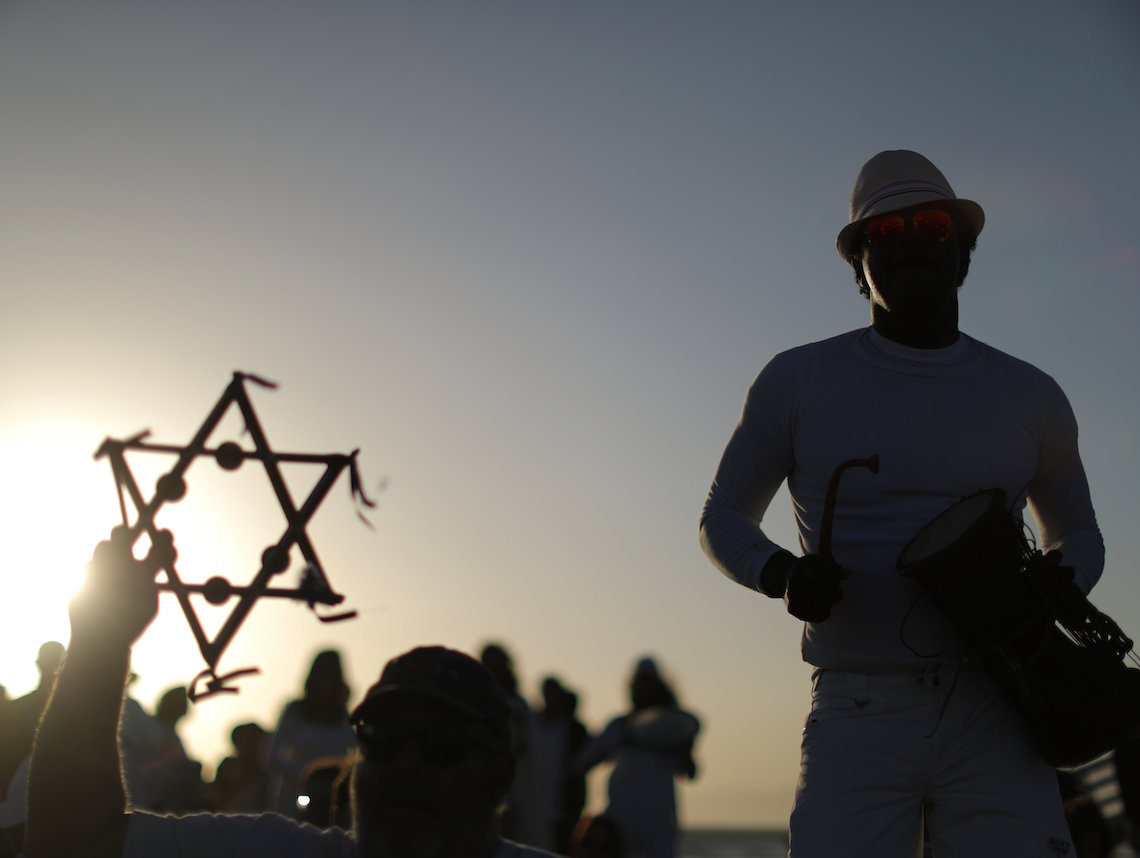 People play instruments during a ceremony on Venice Beach. Photo by Lucy Nicholson/REUTERS.
People play instruments during a ceremony on Venice Beach. Photo by Lucy Nicholson/REUTERS. Kol Nidre ve’esarei
Every year, during the month of Elul, if not before, cantors return to these ancient Aramaic words in reverential search of meaning and inspiration, for they possess a power beyond any others in our long liturgical tradition.
What is it about these seemingly simple, legalistic terms that hold such mystery and transformative power? To me, the compelling power of the Kol Nidre prayer is founded on two truths: 1) the meaning is the moment, and 2) the power of melody.
First, a brief history of this storied text. The first appearance of the opening words of Kol Nidre (literally, “all vows”) has been found on bowls used for magical incantations, curses and spells, which were discovered in ancient Persia (now Iran), dating as far back as the seventh century C.E. Consider this for a moment: The origin of Kol Nidre is a magical spell to deflect harmful curses.
We next encounter an expanded version in the ninth century siddur edited by Rav Amram Gaon. When it appears again a couple of centuries later in the Machzor Vitry, the custom of chanting Kol Nidre three times has taken hold and its meaning has been transformed from magical incantation to legal document, granting the annulment of vows.
This practice eventually led to a controversy that reached its apex in the 19th century, when German Reform rabbis were forced, in response to virulent anti-Semitic charges of dishonesty, to delete Kol Nidre from the machzor. The anti-Semitic claims used Kol Nidre as a proof text for Jewish distrust. Anti-Semites would say, “Look at the Jews! On their holiest day of the year they state openly that their vows are not valid.”
Until its reinstatement in the Reform machzor in 1961, the Jewish community took solace in its melody. The Kol Nidre melody that Ashkenazi Jews recognize as traditional originated in the 16th century and became embellished over the next several centuries. Its collection of simple, short melodic fragments are woven together to form an unforgettable musical moment in sacred time.
Consider the power of just two simple notes, those first two notes of Kol Nidre. In those two notes, an entire community is bound together. Beethoven also needed only two notes to compose what is arguably the most memorable symphony ever composed, his Fifth Symphony.
So potent were those first two notes of Kol Nidre that there was an outcry among the German Reform Jews when the text was deleted from their machzor. However, it wasn’t the text they desired, but the melody. In response, they chose a psalm sung in German to the Kol Nidre melody as a temporary replacement.
The other part of Kol Nidre’s power is the moment. The beginning of the evening of Yom Kippur is arguably the most palpable moment in the entire Jewish communal year. According to our tradition, our very lives hang in the balance. We dress in white and refrain from eating and drinking, as if preparing for our own funeral. We are facing death. Kol Nidre, with its strange and controversial history, its simple but unforgettable melody and the very sounds of its ancient Aramaic words all converge in what is a holy moment in time.
Chanting Kol Nidre for the first time remains a powerful and intimate memory. I was a high school senior in my hometown of Cleveland when our 2,000-member Conservative synagogue experienced a breakup. For reasons unimportant now, nearly 500 members decided to form their own congregation, and I was asked to serve as cantorial soloist.
I was honored to accept but also concerned at my lack of experience and the enormity of the responsibility. I spent the summer preparing with relentless diligence, rehearsing with my accompanist and eight-voice choir. In the end, I felt ready and worthy. Rosh Hashanah went well and I was emboldened with confidence in anticipation of what we then commonly referred to as “Kol Nidre Night.”
When that moment came, I found myself trembling with fear. I remember being grateful for the loose-fitting white robe that hid my shaking legs. I began the first of the traditional three offerings with timidity, which was all I had at that moment. Then the second with growing confidence, and by the third I was fully present.
I honestly don’t remember much of what followed, other than complete relief and exhaustion. Still, years later, the fear and trembling are present — not from inexperience, but rather from a deeper and more mature understanding of the moment and it’s meaning.
So what does a 21st century cantor do to prepare for such a monumental moment in the Jewish communal drama? We do what we’ve always done. We delve yet again into its history, text and melody, the countless commentaries and personal stories. Deeper and deeper we search so that in that Kol Nidre moment we can let go and become fully present, one with the entire community of Jews as time stands still.
Cantor Don Gurney is a cantor at Wilshire Boulevard Temple.























 More news and opinions than at a Shabbat dinner, right in your inbox.
More news and opinions than at a Shabbat dinner, right in your inbox.